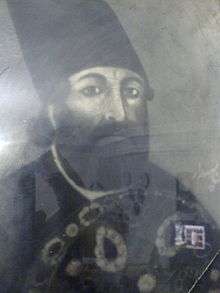Yusef Khan-e Gorji
Yusef Khan-e Gorji (also spelled Yūsof; Persian: یوسف خان گرجی; died 1824) was a Qajar Iranian military leader and official of Georgian origin. An influential figure, he founded the Iranian city of Arak.[1]

Biography
Yusof Khan Gorji was given refuge by the Iranian king Agha Mohammad Khan Qajar (r. 1742–1797) following a territorial dispute with his cousins who were supported by Imperial Russian Empress Catherine the Great. In the period between 1795 and 1797, Yusef Khan-e Gorji, renamed Yusef Khan-e Sepahdar by the king, settled his army in the fertile though poorly controlled territory that would become modern Arak. Hostile tribes in this region had operated autonomously from Qajar rule. With the Iranian king Fat'h Ali Shah Qajar’s approval, Yusef Khan diverted the main river to drive out the hostiles and built the Soltan Abad fortress, or Baladeh, a war fortress to serve as the foundation of what would become modern Arak. Yusef Khan’s organized military force was established in this region aptly named (or more accurately, re-named) "Persian Iraq" (ʿEraq-e Ajam) (عراق عجم) from ancient times meaning 'smooth land'. According to historians, Yusef Khan built Arak from his own personal income and with the aid of affluents.[2][3][4][5][6][7][8][9][10] Some time before 1824, he was appointed by the same aforementioned Qajar ruler Fath-Ali Shah Qajar as the personal vizier of the latters son, Mohammad Mirza Seyf od-Dowleh.[11] Upon his death in 1824, he was succeeded on this post by Khosrow Khan Gorji.[11]
See also
References
- de Planhol 1986, pp. 247-248.
- "Archived copy". Archived from the original on 13 April 2009. Retrieved 2 January 2009.CS1 maint: archived copy as title (link)
- Radcom. "معرفی استان مرکزی | وزارت تعاون". Markazi.icm.ir. Retrieved 19 October 2011.
- "My Daily Diving: یوسف خان گرجی و قلعه سلطان آباد".
- "گرجیان ایران در تاریخ". Kartvelebi.blogsky.com. Retrieved 19 October 2011.
- "شهعřżř§Řąűœ اعř§Úš". Arakcity.ir. Retrieved 19 October 2011.
- "INFO". Jjtvn.ir. Retrieved 19 October 2011.
- "Archived copy". Archived from the original on 30 January 2009. Retrieved 2 January 2009.CS1 maint: archived copy as title (link)
- "هفته نامه اورين خوي – آثار باستاني خوي". Avrinkhoy.blogfa.com. Retrieved 19 October 2011.
- "روزنامه کیهان". Kayhannews.ir. Retrieved 19 October 2011.
- Hirotake 2009.
Sources
- de Planhol, X. (1986). "ARĀK". Encyclopaedia Iranica, Vol. II, Fasc. 3. pp. 247–248.
- Maeda, Hirotake (2009). "ḴOSROW KHAN GORJI QĀJĀR". Encyclopaedia Iranica.CS1 maint: ref=harv (link)
- Mirzai, Behnaz A. (2017). A History of Slavery and Emancipation in Iran, 1800-1929. University of Texas Press. p. 108. ISBN 978-1477311868.CS1 maint: ref=harv (link)
External links
- "Archived copy". Archived from the original on 7 December 2008. Retrieved 2 January 2009.CS1 maint: archived copy as title (link)
- "New Page 1".
- "Chn | News". Chn.ir. Retrieved 19 October 2011.